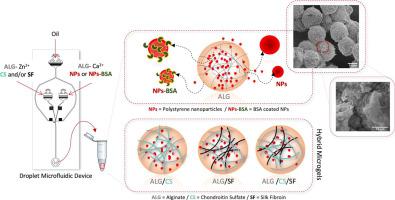Materials Science and Engineering C Pub Date : 2020-08-30 , DOI: 10.1016/j.msec.2020.111467 Bruna Gregatti de Carvalho , Thiago Bezerra Taketa , Bianca Bonetto Moreno Garcia , Sang Won Han , Lucimara Gaziola de la Torre

|
Drug delivery for treatment of chronic diseases relies on the effective delivery of payload materials into the target cells in a long-term release. In this context, the present study investigated hybrid microgels as platforms to carry nanoparticles to drug delivery. Hybrid microgels were produced with silk fibroin (SF) and chondroitin sulfate (CS), and alginate (ALG) by droplet microfluidics. ALG/SF, ALG/CS, and ALG/CS/SF microgels, ranging from 70-90 μm, were tested to encapsulate two model nanoparticles, polystyrene latex beads in pristine form (NPs) and NPs coated with bovine serum albumin (NPs-BSA) to simulate hydrophobic and hydrophilic nanocarriers, respectively. IR spectroscopy and fluorescence microscopy analysis confirmed the presence of SF and CS within ALG-based microgels revealing marked differences in their morphology and physicochemical properties. The release profiles of model nanoparticles revealed to be dependent on microgels composition and physicochemical properties. These findings show that SF ternary hybrid microgels facilitated the entrapment of hydrophobic nanocarriers with encapsulation efficiency (EE) from 83 to 98 % keeping a better sustainable profile release than nonhybrid ALG microgels. Besides, CS improved the carriage of NPs-BSA (EE=85 %) and their profile release. The results highlight the versatility and tunable properties of these biobased microgels, being a good strategy to be used as an efficient platform in using macro and nanoencapsulated systems for drug delivery.
中文翻译:

通过液滴微流体产生的混合微凝胶,用于可持续输送疏水性和亲水性模型纳米载体
用于治疗慢性疾病的药物递送依赖于将有效负载材料长期释放地有效递送到靶细胞中。在这种背景下,本研究研究了混合微凝胶作为携带纳米颗粒进行药物输送的平台。通过液滴微流体技术用丝素蛋白(SF)、硫酸软骨素(CS)和海藻酸盐(ALG)生产混合微凝胶。测试了 ALG/SF、ALG/CS 和 ALG/CS/SF 微凝胶(范围为 70-90 μm)封装两种模型纳米颗粒:原始形式的聚苯乙烯乳胶珠 (NPs) 和涂有牛血清白蛋白的 NPs (NPs- BSA)分别模拟疏水性和亲水性纳米载体。红外光谱和荧光显微镜分析证实基于 ALG 的微凝胶中存在 SF 和 CS,揭示了它们的形态和物理化学性质的显着差异。研究表明,模型纳米粒子的释放曲线取决于微凝胶的组成和物理化学性质。这些发现表明,SF 三元混合微凝胶促进了疏水性纳米载体的包封,封装效率 (EE) 从 83% 提高到 98%,与非混合 ALG 微凝胶相比,保持了更好的可持续释放特性。此外,CS 改善了 NPs-BSA (EE=85%) 的携带及其分布释放。结果强调了这些生物基微凝胶的多功能性和可调特性,是一种很好的策略,可用作使用宏观和纳米封装系统进行药物输送的有效平台。



























 京公网安备 11010802027423号
京公网安备 11010802027423号